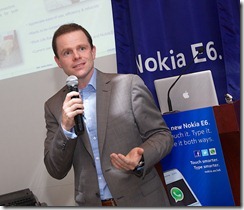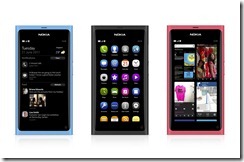Nokia’s fortunes in the high-end, smart- and feature-phone market have plummeted since the introduction of the first iPhone in 2007. Since then, other manufacturers including Samsung and Research In Motion have also done their best to further carve into Nokia’s market leadership position, leaving the Finnish manufacturer needing to adapt and reinvent itself or risk being left behind in the social media-driven communications world that exists
Tom Farrell was appointed GM of the Lower Gulf region for Nokia in April 2011
The ousting of Nokia CEO Olli-Pekka Kallasvuo in September 2010, and his replacement by Microsoft alumni Stephen Elop, was a clear indication by the Finnish manufacturer that drastic changes had to be implemented as its stock price collapsed, its device roadmap failed to inspire enthusiasm, and its rivals appeared to be in better touch with consumer trends.
One of Elop’s first major moves was the announcement, in February 2011, of the manufacturer and Microsoft’s intention to jointly create market-leading mobile communications products, with each company focusing on its core competencies. Amongst the central terms of the agreement, Nokia adopted Windows Phone as its principal smartphone strategy, agreeing to help drive the future of the mobile operating system. Nokia also agreed to contribute its expertise on hardware design, language support, and helping bring Windows Phone to a larger range of price points, market segments and geographies.
The wisdom of such an alliance is likely to be tested in the quarters and years to come, though Nokia’s ongoing popularity in entry- and mid-range devices in emerging markets such as the Middle East is one source of positivity for the company.
In April, Tom Farrell was appointed GM for Nokia Lower Gulf, a region comprising the UAE, Bahrain, Kuwait, Qatar and Oman. Unlike in Europe, handset manufacturers in the Middle East rely more heavily on third-party retailers and mobile stores rather than directly on service providers for the sale of devices, making it crucial for handset manufacturers to know what end-users are using their phones for, and which applications are proving to be most popular.
“This is a strong region for Nokia,” Farrell said. “Six out of every 10 subscribers are using a Nokia device, and what we see is that convergence is accelerating and don’t believe that one company has the ability to do everything or win in every market segment,” he added.
Farrell believes that the Nokia’s pragmatic position to challenges has been key to its success since the beginning of the new chapter in the company’s history in 1989 when it delivered its first GSM network to the Finnish operator Radiolinja. Part of this pragmatism, Farrell stated, is in the establishment of value-creative alliances, though he did also acknowledge Nokia is facing especially challenging times currently.
The tie-up with Microsoft and selection of Windows Phone as its smartphone software of choice surprised many analysts and industry commentators given the relatively insignificant impact Microsoft has thus far had in translating its huge success in the PC software space to the mobile environment. As the world’s largest handset manufacturer, Nokia’s Symbian operating system had built up strong traction, and there was also the choice of adopting the Android operating system, devised by Google and embraced by a slew of manufacturers emerging from the East.
Nokia is pinning a lot of its smartphone hopes on the N9, which it believes will help redefine user interfaces
In an open letter circulated in March by Nokia’s VP responsible for Forum Nokia, Purnima Kochikar, it was forecast that Symbian would likely fade away, though Nokia said it was planning to introduce a number of devices during the "transition period" of 2011-2012 that would feature the Symbian operating system.
"In many markets, including those where Symbian is currently the lead smartphone platform with significant market share, such as China, India, Russia and Turkey, we will continue to make our Symbian portfolio as competitive as possible while we work with Microsoft to introduce Windows Phone," Kochikar said in the statement targeted at Nokia developers. No specific date has been offered as to when the manufacturer will stop supporting Symbian.
Symbian is forecast to become a “franchise platform”, with Nokia expecting to sell approximately 150 million more Symbian devices in the years to come. At the time of the announcement of the agreement with Microsoft in February, Nokia’s Elop said by choosing to adopt Windows Phone as its platform of choice, this helped keep the operating system ecosystem competitive, allowing for a wider selection of platforms and avoiding a duopoly between Google’s Android and Apple’s iPhone operating systems.
“The size of Microsoft and the resources it dedicates to R&D are very attractive,” Farrell said. “In terms of retail and distribution, Microsoft is also unparalleled, and we are looking to combine clouds as well.”
From a business case perspective Nokia does benefit from cash and payments coming in from Microsoft as part of the agreement, and Farrell reiterated that he believes three is a good number of choices to have in the operating system space.
Nokia has been labelled a victim of its own success, having dominated the global mobile handset manufacturing market throughout the 1990s and early part of the last decade. However, as feature phones gained popularity and developed into smartphones, Nokia’s innovative edge appeared somewhat blunted as compared to the new players that had started combining fantastic form factors with impressive applications.
“We have not stopped innovating, that’s for sure,” Farrell said. “Our pipeline of new devices is very exciting and I think in the coming quarters the public will begin to notice that Nokia is back in a strong way.”
Much of the criticism of Nokia’s innovation has been levelled at its high-end devices, which having been at the forefront of feature phone development 10 years ago, have failed to keep abreast with the latest trends in the market, and as a consequence has seen Nokia’s market share in the segment fall. Thus a lot is riding on the launch and reaction to the forthcoming N9 device, which introduces an innovative new design from Nokia where the home key is replaced by a simple gesture: a swipe. Whenever the user is in an application, swiping from the edge of the display takes him home.
The three home views of the user interface are designed to give fast access to the most important things people do with a phone: using apps, staying up to date with notifications and social networks, and switching between activities.
The 3.9-inch AMOLED screen is made from scratch-resistant curved glass, with the polycarbonate body enabling superior antenna performance. This means better reception, better voice quality and fewer dropped calls.
While the N9 will represent one of the flagship devices pointing to the company’s attempted resurgence, the manufacturer is looking to continue to populate its entire product portfolio with desirable devices. Farrell explained that the Nokia C3, for example, is priced at around AED399 (US$109), comes equipped with a QWERTY keyboard, and has a huge downloading capability. The Nokia E3 is essentially a business-oriented phone that Farrell revealed has resonated well in consumer markets, and further momentum is expected to be gained through the introduction of the first Windows Phone devices in Q4.
“We are going to build a family of Windows Phone devices over the next 12-15 months, and the capabilities of the devices will not just be restricted to the pocket but will also extend to the cloud,” Farrell said.
The introduction of Apple’s first tablet device, the iPad, at the beginning of 2010 led to a frenzy of competing tablet launches from traditional and non-traditional mobile device manufacturers, with IDC forecasting that more than 20 million tablet devices are set to be shipped in the EMEA region alone during 2011. Nokia, however, remains decidedly unimpressed with the tablet opportunity, believing there are too many players already supplying the market, which will push down margins and make it difficult to make money off of the devices.
The Middle East region remains a strong one for Nokia devices, with the handset manufacturer still enjoying a leadership position overall
Research In Motion (RIM) is a case in point as it struggles to push numbers of its PlayBook tablet. In September it was reported that the Canadian device manufacturer was to cut production orders for the PlayBook following poor sales, leading to around 1,000 job losses at the outsourced factory, Quanta Computer.
RIM had forecast sales of 4-5 million PlayBooks in 2011, but reported sales of less than 800,000 in the first six months of the year.
With respect to Farrell’s immediate geographic region of responsibility, he believes operators in the Lower Gulf are keen to see a strong Nokia given the long relationships that already exist and the close link between the success of telecom operators on the region and that of Nokia.
“Together with telecom operators we are exploring ways in which to monetise the mobile broadband opportunity effectively, and this extends to things like billing integration with operators, for example,” Farrell said. “We are operator-friendly.”
Looking ahead, Farrell said Nokia remains in the early stages of its turnaround mode, and that given the rapid pace of change in the industry, it should not be long before the positive results become evident.
“We are looking to become the destination for all cool things,” Farrell concluded. “It’s about being cool and connected, with collaboration being key.”





0 comments ↓
There are no comments yet...Kick things off by filling out the form below.
Leave a Comment